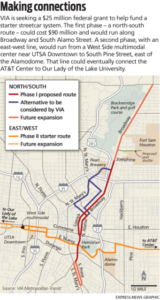Our city leaders, county leaders, and VIA have secured the funds to begin construction of San Antonio’s new streetcar system. Vianna Davila explains in this article for the Express-News how they were able to do it.
Local funds for streetcar found
Two lines, four directions — without federal help.
By Vianna Davila, San Antonio Express-News, Thursday, November 10, 2011
County and VIA Metropolitan Transit officials have identified enough local funds to build the city’s first two streetcar lines without help from the federal government.
They will announce the funding strategies and how they cobbled together the $59 million they needed to finish the system at a news conference today.The total cost for VIA’s expansion is $239 million, which includes money for two downtown streetcar lines running north and east, and west and south, plus a slew of other transit projects in and beyond downtown.
By committing funds to build the entire system, San Antonio can now leverage the project for future federal transportation dollars, said VIA Board Chairman Henry Muñoz III.
“We have now gone back to Washington, D.C. with a priority, and that priority is inner-city streetcar, modern streetcar and the impact that it can have,” Muñoz said.
VIA and the county each will contribute $92 million to the project.
VIA will supply $70 million in bonded funds, $8 million that had been set aside to match expected federal dollars for streetcar, and $14 million from its bus fleet replacement reserve account, VIA CEO and President Keith Parker said.
Parker said because the agency budgets conservatively and has received money for bus upgrades in recent years, it can afford to shift those dollars to streetcar plan. The agency will replenish the reserve account before the fleet needs to be replaced, and without hurting “the overall quality of the system.”
The county had originally dedicated $55 million of advanced transportation district revenues for the streetcar system. It will now increase the amount with ATD revenue bonds to be paid back with the county’s share of the ATD tax, said County Manager David Smith.
Voters approved the one-quarter cent ATD tax in 2004.
The city’s contribution to the multimodal plan will remain at $55 million.
Last month, the City Council voted to enter into an interlocal agreement with the county and VIA, and to support construction of a streetcar line to run north and east through downtown, a project that would cost about $122 million.
VIA has always planned to build a downtown streetcar system that goes in all four directions. With the new funding, VIA will be able to do that and build routes that go west, to the West Side Multimodal Center, and south to the intersection of Alamo and St. Mary’s streets. That second line is estimated to cost about $68 million.

Streetcar System Map
The agency also hopes to pursue federal money to extend the line to Probandt Street, just past the Blue Star Arts Complex, Muñoz said.
While all three entities have been united in their pursuit of San Antonio’s first modern rail line, the push to build the entire system with local funds largely was fueled by behind-the-scenes efforts of County Commissioner Paul Elizondo.
VIA officials had originally voted to pursue construction of an east-west streetcar route, with plans to later build a north-south line, completing the starter system.
The county originally supported that plan. But the city wouldn’t sign on, and eventually the city and county agreed to build a north-to-east line first, down Broadway and through HemisFair Park.
Frustrated by the change, Elizondo urged Bexar County Judge Nelson Wolff and VIA to scrub their respective budget numbers again and look for other funding opportunities.
“I was flabbergasted in a way, because I wanted it (streetcar) for the people that are actually VIA’s best customers,” said Elizondo, adding that most of VIA’s current customers live on the West Side. “That’s the people we should be trying to service, and those are your bus riders.”
“I didn’t think the VIA ridership was being represented in the decisions that were being made,” Elizondo said.
A meeting in Washington, D.C. two weeks ago, between federal transportation officials and a San Antonio delegation that included VIA, Elizondo, Wolff and Castro, confirmed for the commissioner that San Antonio would have to fund the entire system with local money, if the city wanted future help from the federal government.
By building a complete system, Elizondo said, the entities will address economic development — the reason the north-east line was pursued first — and ridership needs.
“Once we invest in this, we step up way in the line (for help from the federal government), because this is a great opportunity for us,” Elizondo said.
Parker said engineers and planners still have to determine when construction can begin, and when the lines are likely to open. He had originally said the north-east route would be up and running by 2015 or 2016. But it’s unclear how the addition of a second line might affect that timeline, and if both lines will open at once or separately.
“I still feel very good we will have something up and going in the year 2016,” Parker said.
